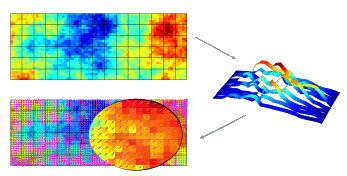GeoScale - Direct Reservoir Simulation on Geocellular Models
You are here:
GeoScale
/
Research areas
/
MsMFEM
|
MsMFEM
Multiscale simulation is a promising approach to facilitate direct simulation of large and complex grid-models for highly heterogeneous petroleum reservoirs. Unlike traditional simulation approaches based on upscaling/downscaling, multiscale methods seek to solve the full flow problem by incorporating subscale heterogeneities into local discrete approximation spaces. We consider a multiscale formulation based on a hierarchical grid approach, where basis functions with subgrid resolution are computed numerically to correctly and accurately account for subscale variations from an underlying (fine-scale) geomodel when solving the global flow equations on a coarse grid. By using multiscale basis functions to discretise the global flow equations on a (moderately-sized) coarse grid, one can retain the efficiency of an upscaling method, while at the same time produce detailed and conservative velocity fields on the underlying fine grid.
The Multiscale Mixed Finite Element Methods (MsMFEM) has shown to be a particularly versatile multiscale method and is one of the key simulation technologies developed in the GeoScale projects.
|
|||


